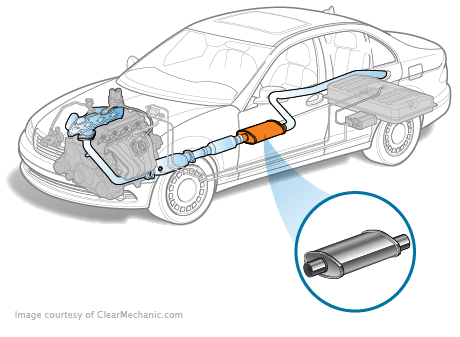Front-wheel drive vehicles and most all-wheel-drive vehicles use a flex pipe in the exhaust system. The flex pipe is necessary to allow the forward and backward rocking of a car engine on starting and acceleration.
Usually, the flex pipe is a short section of exhaust made from a flexible accordion pipe and protected with a braided wire covering.
A flex pipe allows a little more freedom in exhaust system design and a little better noise and vibration absorption in the engine mount system.
Costs of Exhaust Flex Pipe Replacement
To get an idea of the average cost of exhaust flex pipe repair is a little difficult, as it can vary widely.
Major factors are state regulations where you live (which can require OE or certified parts), how the vehicle is built (whether the flex pipe is combined with the catalytic converter, mainly), and where you take the vehicle for repair. Most shops will be limited to bolting on OE-style parts. An exhaust shop, on the other hand, would have more options as far as fabricating or adapting cheaper universal parts, if state regulations allow.
An average cost to have a universal flex pipe welded in at an exhaust shop might be about $200. If the flex pipe comes separate from the catalytic converter, an average replacement cost might be about $400 at a general repair shop. If the flex pipe is replaced with the catalytic converter, the average repair cost might be about $1500.
For some specific more estimates of the cost of replacing a flex pipe on some common vehicles, using $100 an hour as a labor rate:
- For a 2002 Hyundai Sonata with a 2.4-liter engine
The labor time to replace the flex pipe is estimated at 0.8 of an hour. On this vehicle, it is a component on an exhaust pipe section that includes the rear catalytic converter.
A factory replacement costs about $1325, and a CARB compliant replacement part costs about $317. The total cost to complete the job would be about $1405 using OE parts, or about $397 using aftermarket parts.
There would also be the option of having an exhaust shop cut out the old flex pipe and welding in a new one, which might cost around $50 for a universal Walker part and an hour of labor.
- For a 2004 Toyota Camry with a 2.4-liter engine
The labor time to replace the flex pipe is estimated at 0.6 of an hour. Also on this model, it is a part of the front pipe which includes the rear catalytic converter.
A factory replacement part costs about $1312, and a Walker CARB compliant part costs about $295. This makes the job about $1372 using OE parts, or about $355 using aftermarket parts. In this case as well, there would be the option of having an exhaust shop cut out and replace just the flex pipe, which might come to about $150.
- For a 2008 Ford Fusion with a 2.3-liter engine
The labor time to replace the flex pipe is estimated at 1.3 hours. A factory replacement part costs about $231, and a Walker part costs about $79. The total cost to complete the job would be about $362 using factory parts, and $209 using aftermarket parts.
On this engine, the flex pipe is built into a simple front pipe that bolts to the catalytic converter on one side, and the main exhaust pipe leading to the rear on the other.
- For a 2009 Chevrolet Traverse with a 3.6-liter engine
The labor time to replace the flex pipe is estimated at 1.2 hours. A factory replacement part is about $477, and a Walker replacement part is about $141. The total cost to complete the job would be about $597 using factory parts and about $261 using aftermarket parts.
This engine is a V-6 and the flex pipe is part of a sturdy y-pipe that joins the two exhaust banks. This is less suitable for a cheaper aftermarket universal flex pipe that could be welded in.
In all cases, there would likely be some additional flange gaskets and miscellaneous fasteners which could yield a relatively small additional cost. The bolts that attach the flanges of exhaust pipes are very prone to heat stress and rust issues and are normally replaced when they have to be removed.
Emission regulations often apply. Depending on exact laws and local regulations, sometimes, the exhaust system can’t be modified in any way, which would require a shop to install a certified replacement part and disallow any universal parts.
The above flex pipe repair cost estimates are for certified parts. If those weren’t required, then, some small amount of savings on non-certified parts would be possible.
Exhaust Flex Pipe Replacement

Flex pipes can be a short bolt-on unit with flanges on either end, which makes replacement fairly simple. Sometimes, flex pipes are built into a larger exhaust assembly.
On some engines, the flex pipe may use slip joints with a clamp at one or both ends; requiring the need for some exhaust tools to replace well. The flex pipe usually fails by breaking internally, which then, causes an exhaust leak and noise.
Depending on how the system is laid out, if the O2 sensors are placed downstream from the flex pipe, there may be fault codes set and running problems in the event of a failure. The O2 sensor information is the basic data the PCM uses to determine fuel mixtures, and that can be thrown off if there are exhaust leaks.
Other Related Parts
The primary purpose of a flex pipe is to absorb the rotational movements of a transverse engine under starting and accelerating forces. If an exhaust flex pipe needs replaced, the main additional part that might be of concern is one that can be a cause of flex pipe failure: the engine mounts.
An engine will usually have one or two engine mounts that specifically limit rotational forces, and if they are worn and allow too much movement that can cause the flex pipe to fail. The engine mounts should be inspected and replaced as necessary in conjunction with a flex pipe failure.
FAQ
The critical part of the flex pipe that fails is the inner accordion-bent pipe, and there is no practical way to reliably repair it.
There is no maintenance interval, and actual failures of an exhaust flex pipe are pretty rare, depending on what part of the country the vehicle is operated in. The primary enemy of an exhaust system is road salt. In a state that has snowy winters and uses road salt, rust will most definitely shorten the lifespan of the flex pipe, along with much of the rest of the vehicle undercarriage.
The main sign is that there is an exhaust leak. Typically that would be the only sign. An exhaust leak will cause noise first when the engine starts and under heavy acceleration, and then more continually if the part is allowed to fail entirely. An exhaust leak can also trigger an engine warning light, as it can allow unmetered air into the exhaust which interferes with oxygen sensor readings, which can cause the PCM to think that other things are wrong. The first step in diagnosing a catalytic converter or O2 sensor code is inspecting the exhaust system for leaks.

